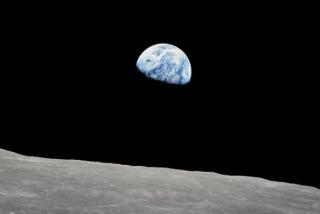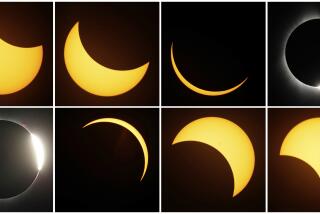Ancient eclipse records show that days on Earth are getting just a little longer

A report published in Proceedings of the Royal Society A found that a single rotation of Earth on its axis has slowed by 1.8 milliseconds per century.
The latest findings in Earth science are brought to you by ancient astronomers who observed the heavens as long as 2,700 years ago.
Thanks to hundreds of records of lunar and solar eclipses carved in clay tablets and written into dynastic histories, modern scientists have determined that the speed at which Earth spins on its axis has slowed by 1.8 milliseconds per day over the course of a century, according to a report published Wednesday in the journal Proceedings of the Royal Society A.
For the record:
9:32 a.m. June 30, 2019A previous version of this story said the time it takes for Earth to complete a single rotation on its axis had slowed by 1.8 milliseconds per century. In fact, the speed of the planet’s spin has decelerated by 1.8 milliseconds per day per century.
It may not sound significant, but over the course of 2½ millenniums, this deceleration adds up to a time discrepancy of about 7 hours.
To be clear, the amount of time it takes for Earth to complete a single rotation has increased by only a fraction of a second over the last 2,500 years. However, if humanity had been measuring time with an atomic clock that started running back in 700 BC, today that clock would read 7 p.m. when the sun is directly overhead rather than noon.
“There is time and then there is how fast the Earth spins,” said Duncan Agnew, a geophysicist at Scripps Institution of Oceanography in San Diego, who was not involved with the work. “Traditionally those things are closely linked, but they are not the same.”
Our earliest ancestors measured time based on the position of celestial bodies in the sky, such as the rising and setting of the sun or the changing shape of the moon. Scientists refer to this as Universal Time, and it is governed by the dynamic gravitational motions of the moon, sun and Earth.
Terrestrial Time, on the other hand, is measured by clocks and is independent of planetary motion. Since the 1960s, it has been tracked by exquisitely precise atomic clocks. According to our modern take on Terrestrial Time, there are exactly 86,400 seconds in a day and each second is defined as exactly 9,192,631,770 oscillations of a cesium-133 atom.
But our planet does not keep perfect time, so Universal Time and Terrestrial Time do not always line up.
In our modern world, governed by atomic clocks, the International Earth Rotation and Reference Systems Service calls for a leap second to be added whenever Universal Time is on track to be out of sync with Terrestrial Time by more than 0.9 of a second. Leap seconds traditionally are added on June 30 or Dec. 31. (In fact, one will be added this New Year’s Eve.)
Earth’s rotational rate, which determines Universal Time, is affected by many factors.
Large weather systems and atmospheric winds can exert enough force on Earth’s surface to cause it to slow down or speed up by thousandths of a second over a single season. Large volcanoes and earthquakes may also cause Earth to speed up or slow down, but these changes are hard to detect. In 2011, a researcher at the Jet Propulsion Laboratory in La Cañada Flintridge calculated that the magnitude 9.0 quake that struck off Japan may have shaved about 1.8-millionths of a second off the calendar year.
The dominant force affecting Earth’s spin rate over longer time periods is the interplay of gravity between the oceans and the moon. Scientists have known for decades that this phenomenon is causing Earth to spin more and more slowly. However, there are other, more subtle factors at play on this timescale as well.
Changes in the amount of polar ice affect the shape of Earth and can impact how quickly or slowly the planet turns on its axis. In addition, movements of molten rock in the planet’s core can affect the speed of its rotation, Agnew explained.
To determine how much all these forces have changed the planet’s spin rate over the centuries, a small group of British scientists took on the herculean task of gathering hundreds of astronomical records made by ancient scribes from around the world.
The team’s goal was to pinpoint when and where lunar and solar eclipses occurred in antiquity, then compare them to computer models of when and where they should have occurred based on the current rate of Earth’s spin. By measuring the difference between these two sets of data, researchers can determine how much Earth’s rotation rate has changed over time.
See the most-read stories in Science this hour »
It wasn’t easy to assemble. Richard Stephenson, an astronomer who recently retired from Durham University in England, started working on this project 40 years ago when he was a young researcher at the University of Essex.
Because nearby Durham University had a good Chinese studies department, he began with ancient texts from China. To aid him in his search, he memorized 1,500 Chinese characters — too few to read a newspaper, but enough to help him decipher astronomical records written into dynastic histories. Over the years, he was able to find about 50 reliable dates and times of solar and lunar eclipses recorded between AD 434 and 1280.
“During that period they were using water clocks to tell time,” he said. These devices work by dripping water into a vessel at a constant rate. “While those are not terribly accurate, if you get 50 observations over a period of time, you can get a good average.”
A treasure trove of data came from translations of clay tablets written in cuneiform by Babylonian astrologers. Although many of the tablets were damaged in the excavation process, Stephenson found more than 150 useful entries dating from 720 BC to 10 BC.
Other observations came from Muslim astronomers working in the Arab world between AD 800 and 1000, as well as from mentions of solar and lunar eclipses in medieval European chronicles, mostly written in Latin.
“The Arab timing of solar eclipses in particular is superb,” Stephenson said. (He could not say the same for the European data.)
Stephenson said he is grateful to all these ancient sky watchers.
“People recording these things never had the slightest notion that what they were doing would lead to people in our generation actually studying changes in the Earth spin,” he said. “We are very much at the mercy of these ancient chroniclers and astronomers.”
He added that despite the crude instruments many of these observers had to work with, they were often remarkably accurate both in their observations and their ability to keep track of time.
“In 90% of the cases in the Chinese and Babylonian records, their dates reproduce exactly to the date of the calculated eclipse,” he said. “This gives us a lot of confidence in our data set.”
Stephenson’s interest in ancient astronomical observations stops around 1600. That’s about when the first telescope was invented and astronomical measurements became significantly more precise.
Luckily, he teamed up long ago with Leslie Morrison, a recently retired astronomer from the Royal Greenwich Observatory in London who has collected thousands of records of lunar occultations from the last 400 years.
Lunar occultations occur when the moon appears to block certain stars from the perspective of an observer.
“After the advent of the telescope and the introduction of pendulum clocks, it was possible to watch the moon approach a star in its path, suddenly block it out, and then see the star reappear again on the other side,” Morrison said. “This allowed us to measure difference in time no longer in hours or minutes, but in seconds.”
Astronomers in the 1600s and 1700s made these observations mainly to try to pinpoint the orbit of the moon. Today, scientists know where the moon and stars were hundreds of years ago. If they know what time the observations were made, they can use all this information to determine how much faster Earth was spinning at the time.
Stephenson and Morrison have continued to work on this project in retirement, and they say they are not necessarily done yet. Stephenson would like to find observations from the Incas and the Maya that could be added to their data set. So far, he said, they have struck out.
He would also like to find more observations from AD 200 to 600. That would help fill their biggest hole.
In the meantime, geophysicists such as Agnew said they will use the astronomers’ work to better understand the forces speeding up and slowing down the spinning of our planet.
“Nothing else on Earth cares about when an eclipse happens, so we have to rely on these observations,” Agnew said. “The most astounding thing about this paper is the fact that we have this information at all.”
Do you love science? I do! Follow me @DeborahNetburn and “like” Los Angeles Times Science & Health on Facebook.
MORE IN SCIENCE:
States with background checks for those who buy guns and bullets also have fewer school shootings
Our ancient relative Lucy spent more time in trees than previously thought
Move over, elephants. Dogs have remarkable memories, researchers say







